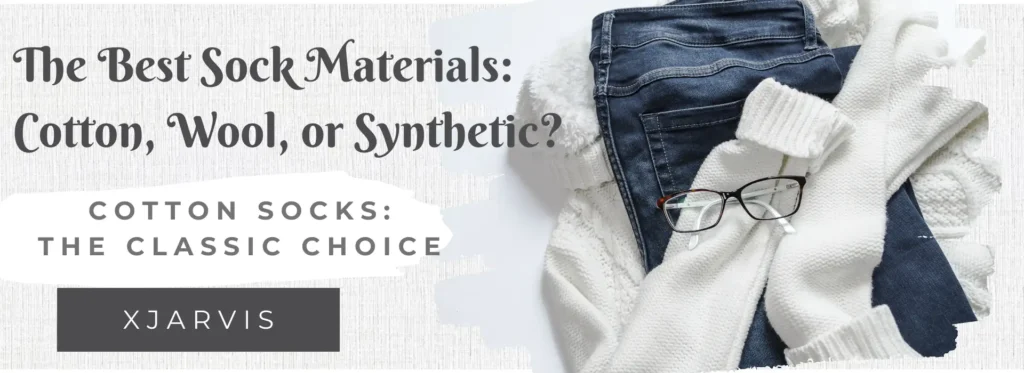Comparing different fabrics to help customers choose the best socks for comfort, durability, and weather conditions.
When it comes to choosing the perfect pair of socks, material matters. Whether you’re looking for everyday comfort, durability, or performance in extreme weather conditions, the fabric of your socks can make all the difference. Cotton, wool, and synthetic fibers are the three most popular sock material, each with unique benefits and drawbacks. In this guide, we’ll compare these fabrics to help you make the best choice for your feet.
Cotton Socks: The Classic Choice
Pros of Cotton Socks:
- Soft and Comfortable: Cotton is a natural fiber known for its softness and breathability, making it ideal for everyday wear.
- Hypoallergenic: People with sensitive skin or allergies often prefer cotton as it is less likely to irritate.
- Lightweight and Affordable: Cotton socks are budget-friendly and widely available in various styles and colors.
- Absorbent: Cotton effectively absorbs moisture, helping to keep feet dry for short periods.
Cons of Cotton Socks:
- Retains Moisture: While cotton absorbs sweat, it does not wick moisture away, which can lead to damp and uncomfortable feet, especially in hot or humid conditions.
- Lacks Durability: Cotton fibers wear out faster than wool or synthetic alternatives, leading to holes and thinning over time.
- Not Ideal for Cold Weather: Cotton does not provide insulation when wet, making it a poor choice for winter activities or hiking in wet environments.
Best For: Everyday casual wear, office settings, and people with sensitive skin.
Wool Socks: The All-Weather Performer
Pros of Wool Socks:
- Excellent Insulation: Wool provides superior warmth in cold weather and can still insulate even when damp.
- Moisture-Wicking: Unlike cotton, wool wicks moisture away from the skin, keeping feet dry and reducing the risk of blisters.
- Odor-Resistant: Wool has natural antimicrobial properties, which help reduce foot odor and keep socks fresh for longer.
- Durable and Long-Lasting: High-quality wool socks, like those made from Merino wool, are resistant to wear and tear, making them a long-term investment.
Cons of Wool Socks:
- More Expensive: Wool socks are generally pricier than cotton and synthetic alternatives due to the premium quality of the material.
- Thicker and Heavier: Some wool socks can feel bulky, which may not be ideal for certain shoe types or warm climates.
- Requires Special Care: Wool socks often need delicate washing and air drying to maintain their quality and prevent shrinking.
Best For: Cold weather, outdoor activities, hiking, and people looking for odor-resistant socks.
Synthetic Socks: The High-Performance Option
Pros of Synthetic Socks:
- Moisture-Wicking and Quick-Drying: Synthetic fibers like polyester, nylon, and spandex are designed to wick moisture away from the skin and dry quickly.
- Highly Durable: Synthetic socks are engineered for longevity, making them a great option for high-impact activities like running and sports.
- Stretchy and Form-Fitting: Many synthetic blends contain elastane or spandex, which helps socks maintain their shape and provide a snug fit.
- Lightweight and Versatile: Synthetic socks come in various thicknesses, offering both warmth and breathability depending on the blend.
Cons of Synthetic Socks:
- Less Breathable: Some synthetic sock materials do not allow as much airflow as natural fibers, which can lead to sweaty feet in hot conditions.
- Can Retain Odor: Unlike wool, synthetic socks do not have natural odor-resistant properties and may require frequent washing.
- May Feel Less Comfortable: Some synthetic socks can feel less soft compared to cotton or wool, depending on the quality of the blend.
Best For: Athletes, runners, gym workouts, and those needing moisture-wicking performance.
How to Choose the Best Sock Material for Your Needs
To determine the best sock material for you, consider the following factors:
- Climate & Weather Conditions:
- Hot & Humid: Lightweight cotton or moisture-wicking synthetics.
- Cold Weather: Wool for warmth and moisture control.
- Rainy or Wet Conditions: Wool or synthetic blends that wick moisture.
- Activity Level:
- Everyday Use: Cotton for comfort and affordability.
- Sports & Workouts: Synthetic socks for moisture control and durability.
- Hiking & Outdoor Adventures: Wool for warmth, durability, and odor resistance.
- Comfort & Skin Sensitivity:
- Sensitive Skin: Cotton or high-quality Merino wool.
- Need Stretch & Support: Synthetic blends with spandex or elastane.
- Durability & Maintenance:
- If you want socks that last longer, opt for wool or synthetic blends.
- Cotton requires frequent replacement due to wear and tear.
Final Thoughts: Which Sock Material is Best?
There is no one-size-fits-all answer when it comes to choosing the best sock material. Each fabric has its strengths and is suited for different occasions and needs:
- For casual, everyday wear, cotton is a comfortable and budget-friendly choice.
- For outdoor adventures and cold climates, wool offers the best insulation and durability.
- For athletes and active individuals, synthetic socks provide moisture-wicking and support.
Ultimately, the best approach is to have a mix of different sock materials in your wardrobe so you can choose the right socks based on your activity and weather conditions. Whether you prefer the softness of cotton, the warmth of wool, or the performance of synthetics, selecting the right fabric will ensure your feet stay comfortable all day long.
Looking for the Best Socks?
Explore our premium collection of cotton, wool, and synthetic socks designed for every lifestyle. Find the perfect pair for your needs today!
